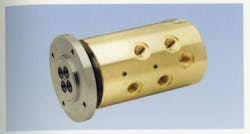The 1379 and 1479 series of rotating unions for hydraulic oil and dry or lubricated air feature four independent passages for applications such as clamping and unclamping, work-piece or tool sensing and spindle coating. Vent between passages two and three allows use of two different media without cross-contamination.
They are rated for speeds of 250 rpm. Maximum pressures are 60 bar (870 psi) while rotating and 250 bar (3635 psi) for very slow rotation for hydraulic and 10 bar (145 psi) for air. Series 1379 is rated for maximum flows of 53 lpm (14 gpm); 1479 series is rated for 108 lpm (28.5 gpm). Stainless steel and brass components resist corrosion.
Deublin USA, (847) 689-8600, bit.ly/hp1112deublin


